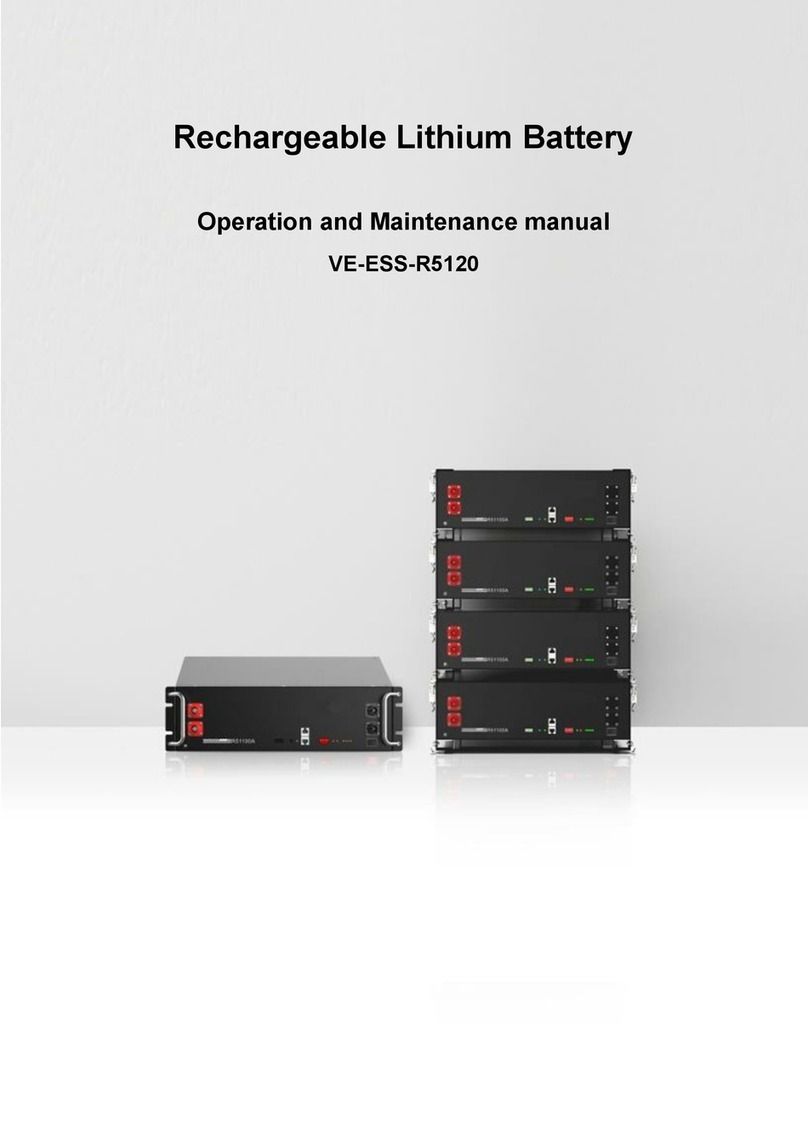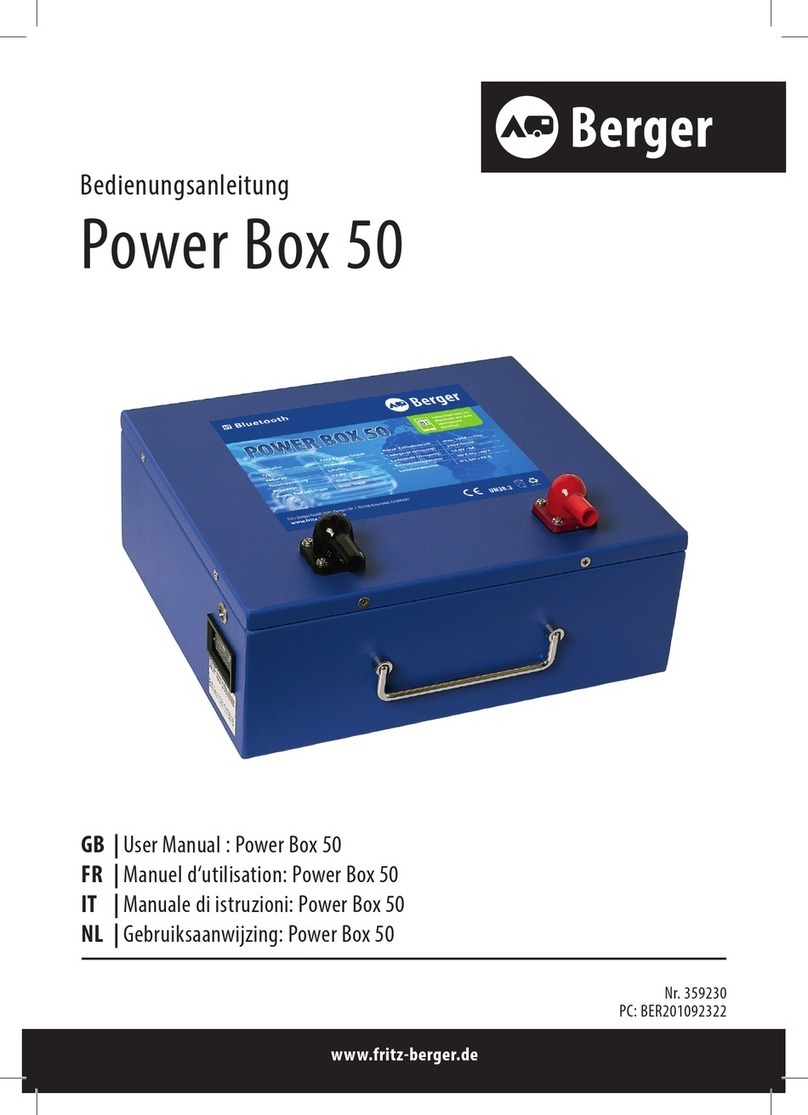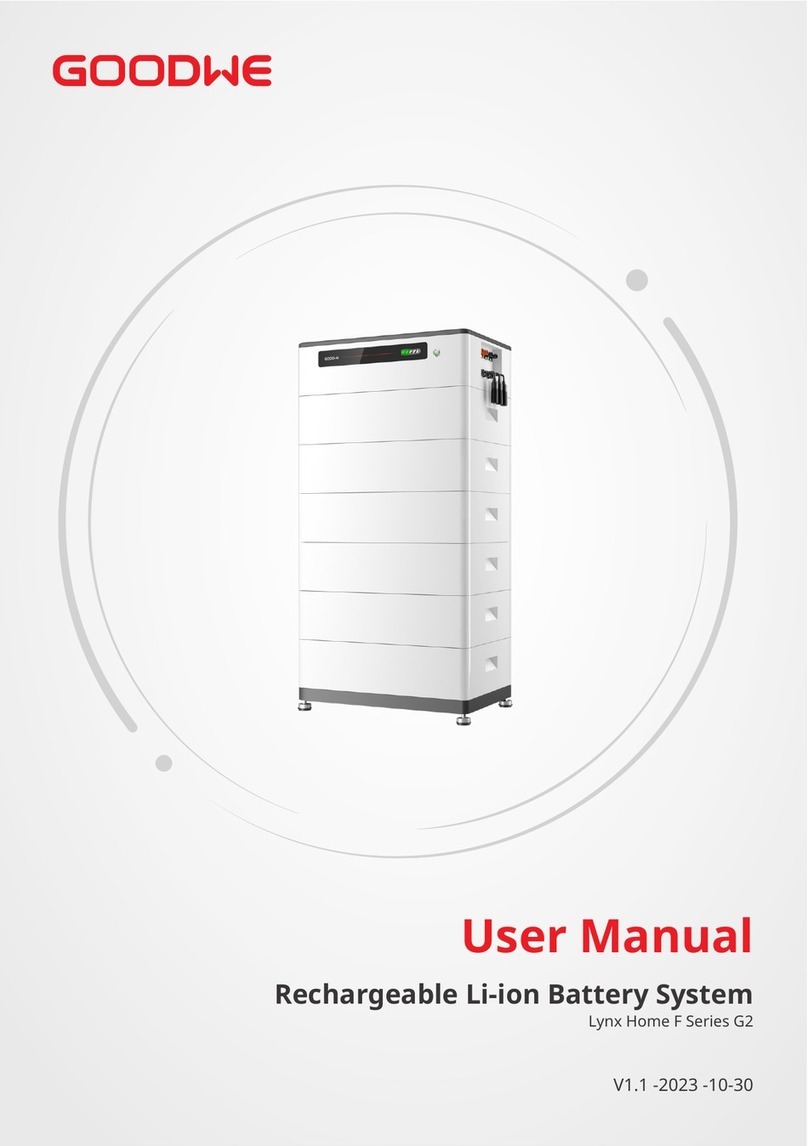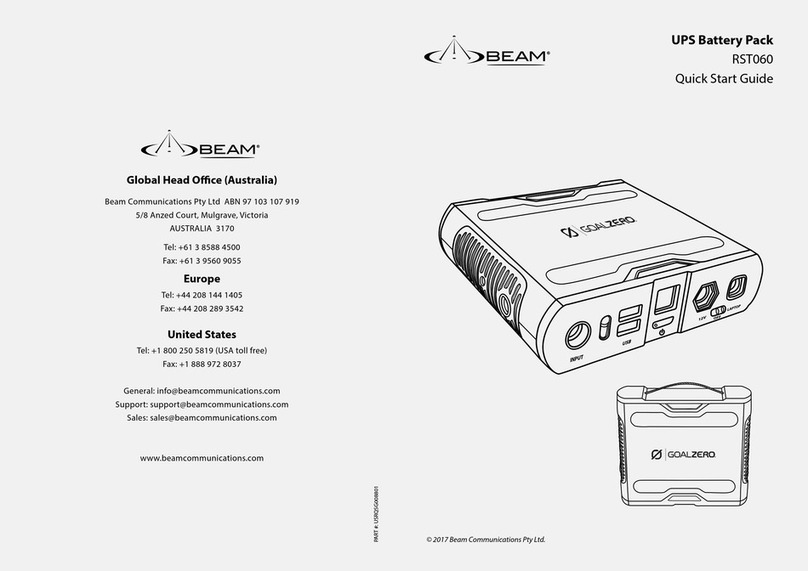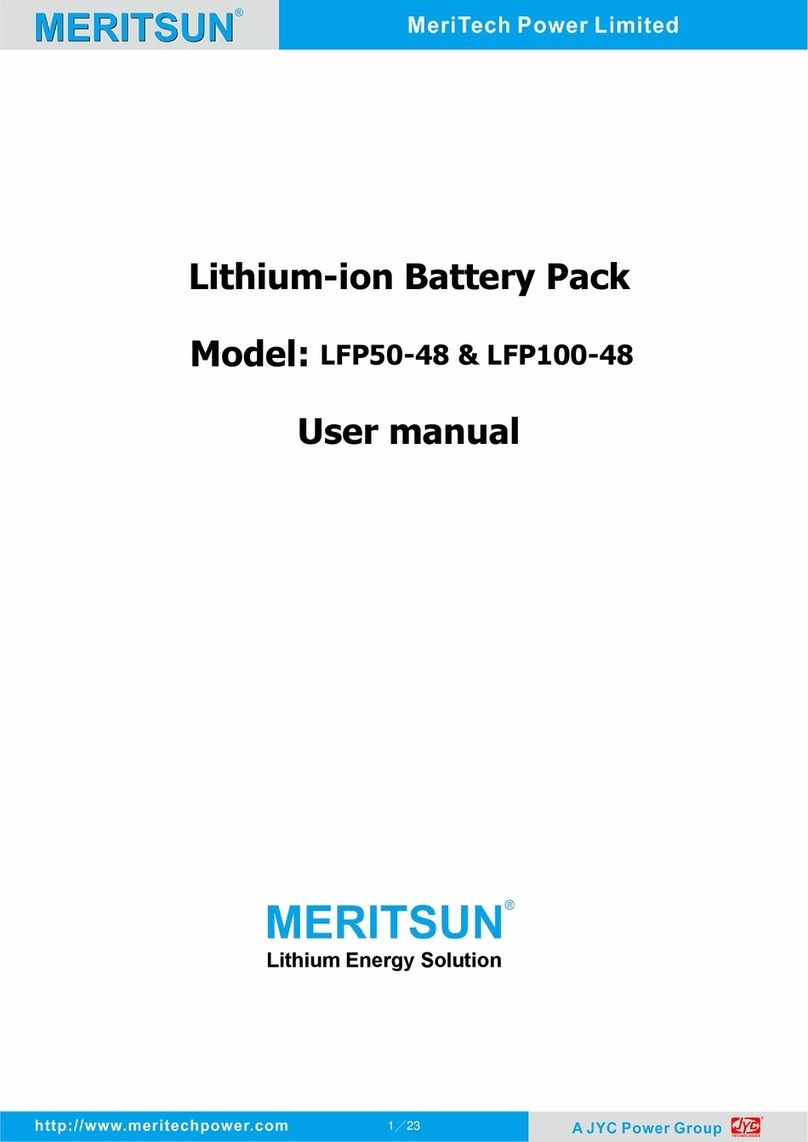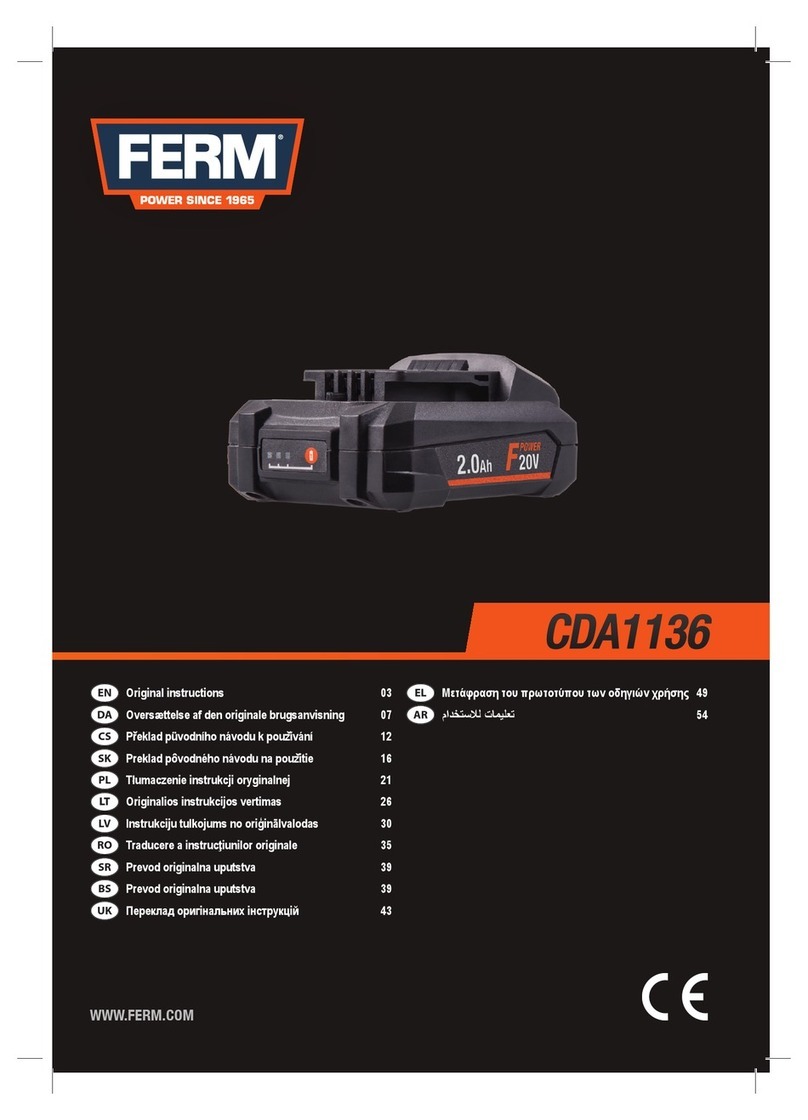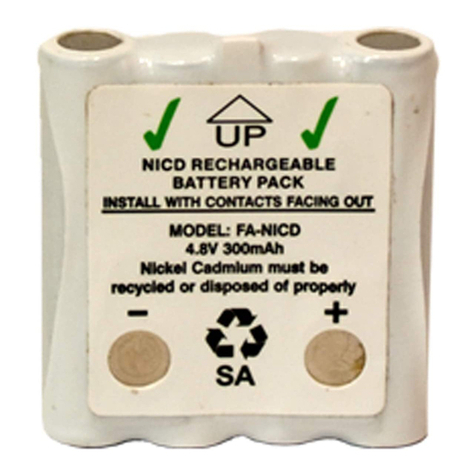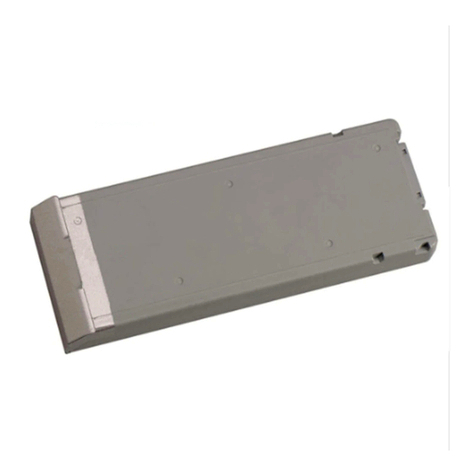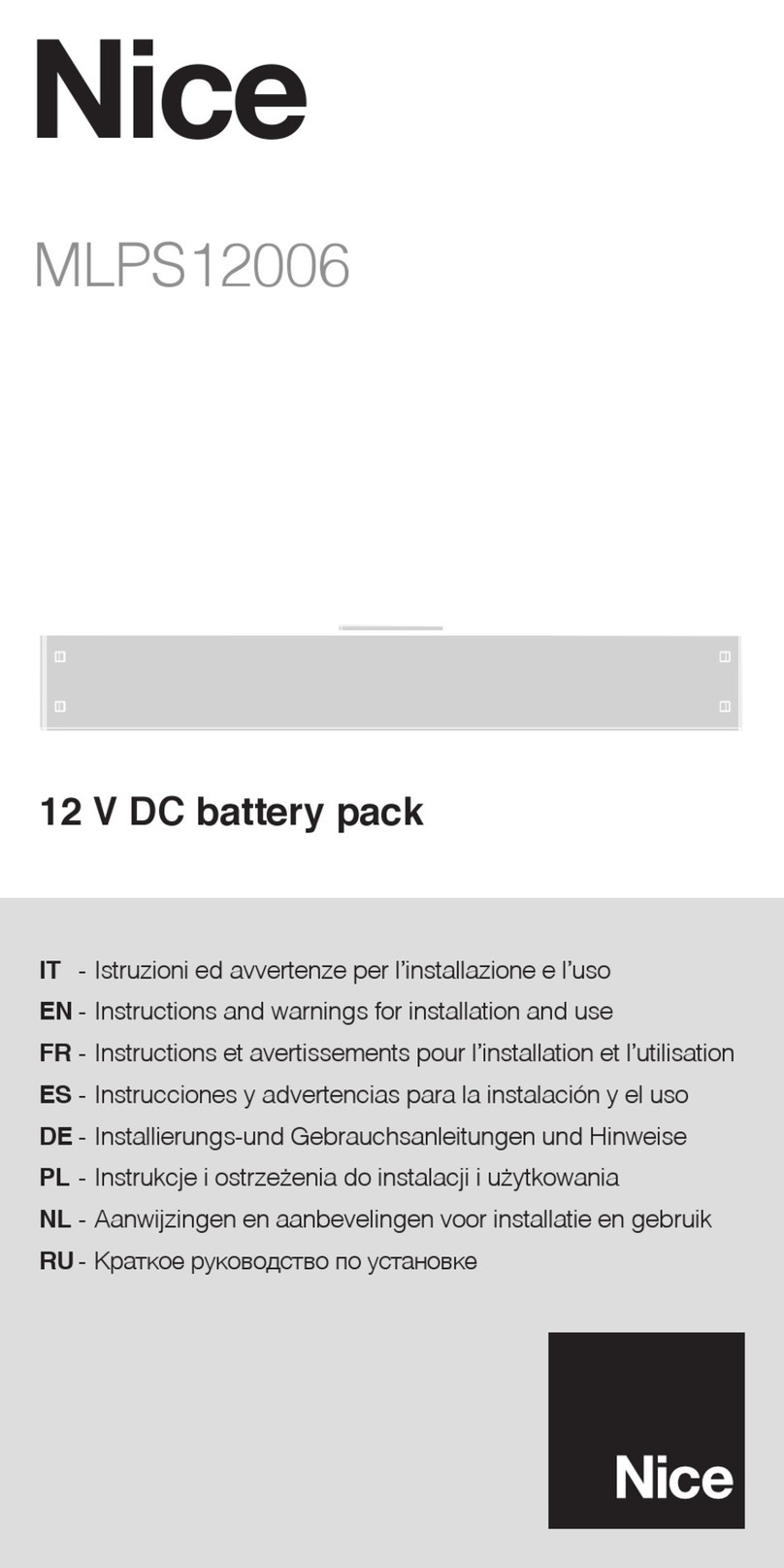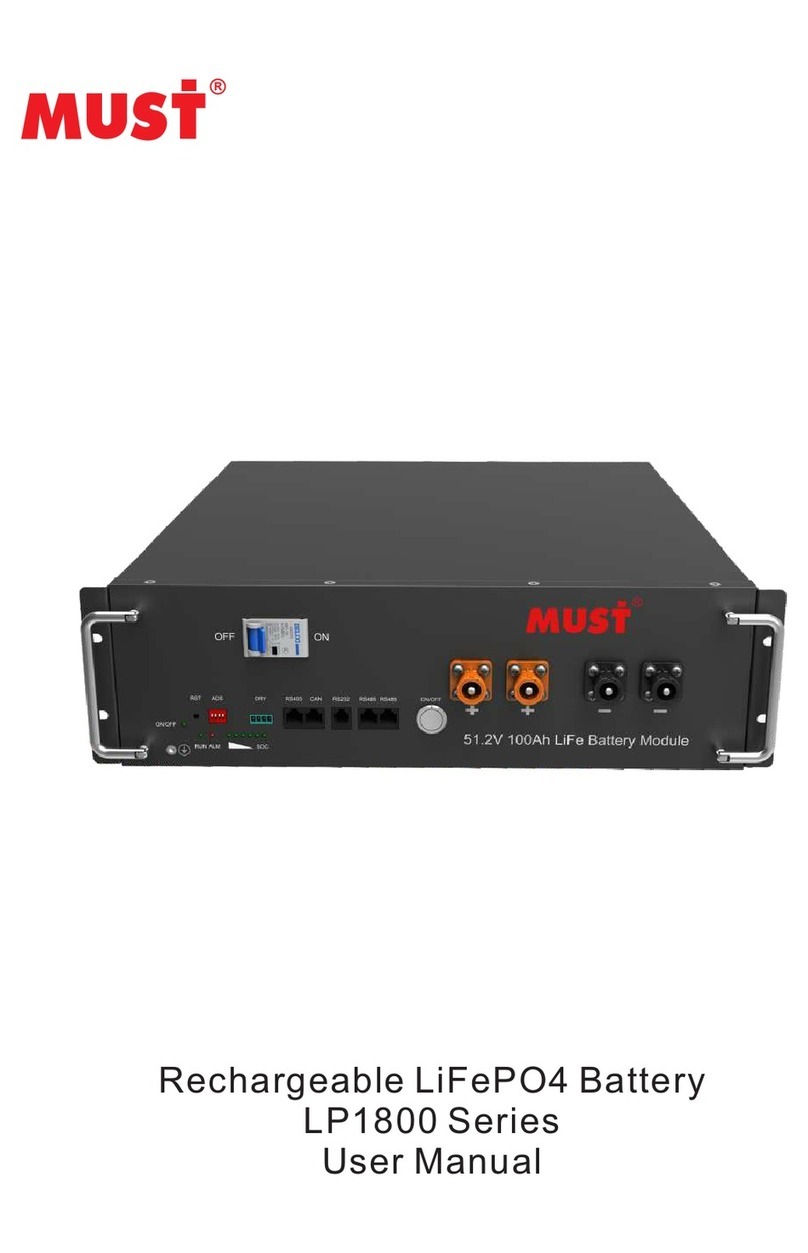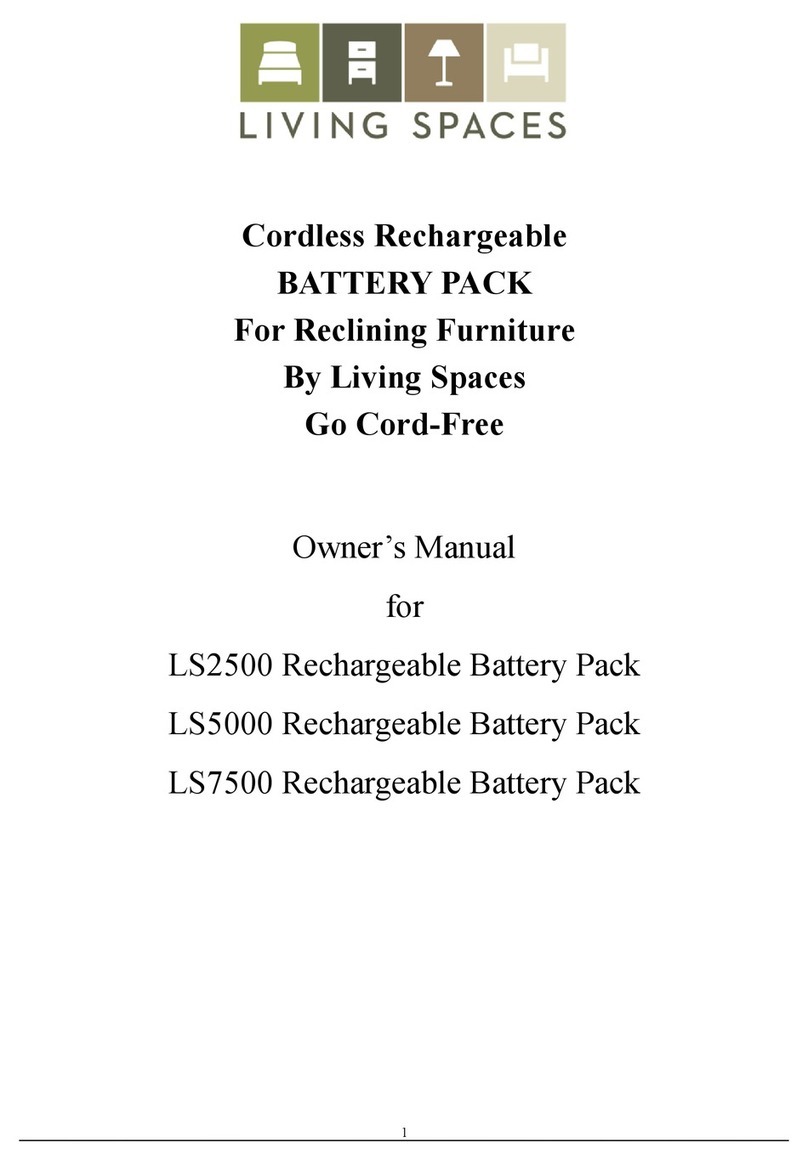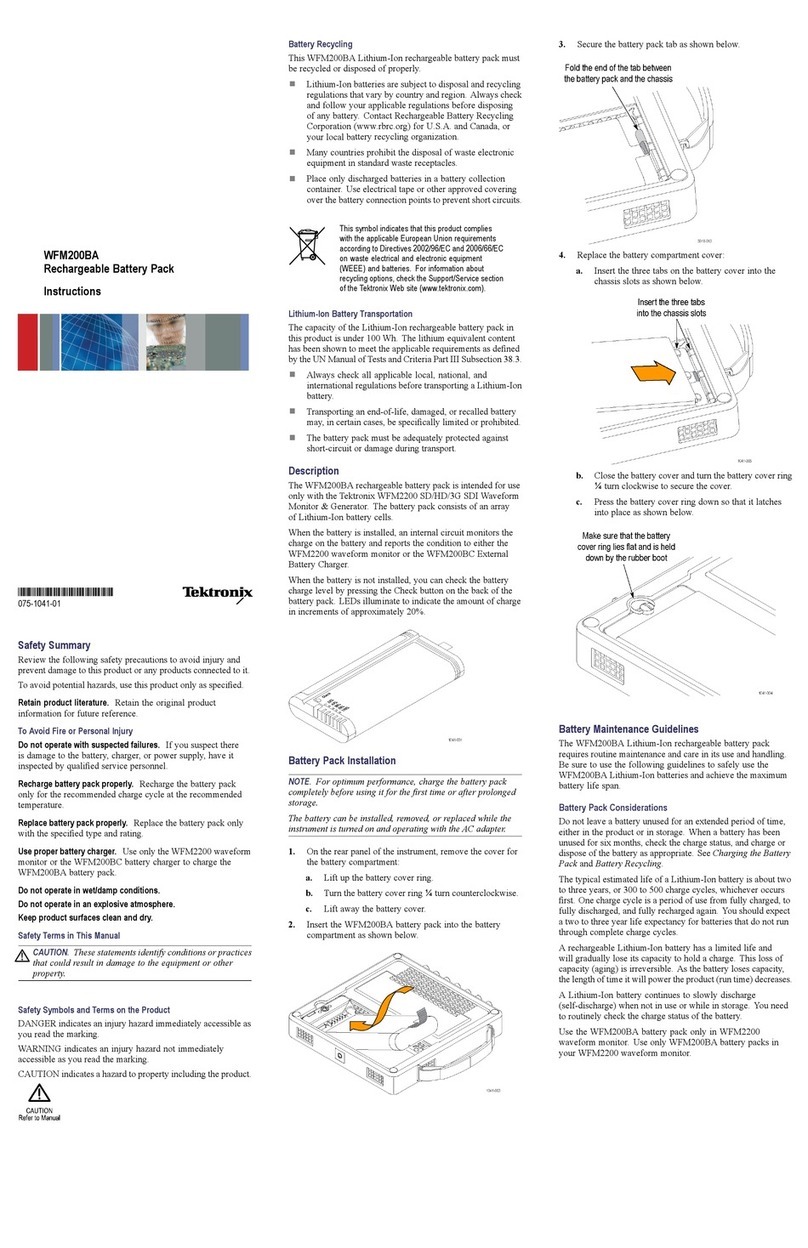Chint Power CPS ESSR-05KL1 User manual

User Manual for CPS ESSR-05/10/15/20KL1
Energy Storage Battery Unit
Shanghai Chint Power Systems Co., Ltd.
Version 1.2 Oct., 2023

Table of Contents
2/ 53
Table of Contents
0Introduction....................................................................................4
1Safety Instructions ........................................................................5
1.1 Explanation of safety symbols in the manual..............................5
1.2 Interpretation of product markings ..............................................6
1.3 Precautions .................................................................................7
2Product Introduction.....................................................................9
2.1 Introduction to residential energy storage battery unit................ 9
2.2 Model marking.............................................................................9
2.3 Instruction of energy storage capacity ......................................10
2.4 Dimension and appearance ......................................................12
2.5 LED display instruction..............................................................16
2.6 Product protection function .......................................................18
3Installation....................................................................................19
3.1 Inspection before installation.....................................................19
3.2 Installation tools ........................................................................21
3.3 Installation torques ....................................................................22
3.4 Installation requirements ...........................................................22
Environment requirements............................................... 22
Installation method........................................................... 23
Installation space ............................................................. 24
3.5 Installation methods ..................................................................25
Floor installation............................................................... 25
Wall-bracket Installation................................................... 28
4Electrical Connection..................................................................31
4.1 Cable specification ....................................................................31
4.2 Tools and torques ......................................................................31
4.3 External wiring ports..................................................................31
4.4 Wiring instructions .....................................................................32
Diagram of system structure............................................ 33
Grounding cable connection............................................ 33
Communication line connection and Power line connection
34
5Trial Operation .............................................................................37
5.1 Installation check.......................................................................37
5.2 Inspection items of cable...........................................................37
5.3 Startup process .........................................................................38
General startup process................................................... 38

Table of Contents
3/ 53
Black start process........................................................... 38
5.4 Shutdown process.....................................................................38
6Storage and Recharging.............................................................39
6.1 Battery storage requirements....................................................39
6.2 Recharging cycle and requirements .........................................40
6.3 Recharging operation................................................................41
6.4 Battery power-on and commissioning steps .............................42
7Maintenance and Replacement..................................................43
7.1 Maintenance precautions ..........................................................44
7.2 Maintenance items and cycle....................................................45
7.3 Fault List....................................................................................46
Troubleshooting of LED indicator .................................... 46
List of faults ...................................................................... 46
8Technical Data .............................................................................49
9Quality Assurance.......................................................................51
9.1 Immunity from liabilities.............................................................51
9.2 Quality terms .............................................................................52

Introduction
4/ 53
0 Introduction
This manual contains important information about product
installation and safe operation. Please read it carefully before use.
Thank you for choosing CPS ESSR L1 Series residential energy storage battery
unit (hereinafter referred to as " battery unit " in this manual) produced by Chint
Power Systems Co., Ltd. (hereinafter referred to as "Chint Power"). With innovative
design and perfect quality control, the energy storage battery produced by Chint
Power has high reliability.
This manual mainly introduces the product characteristics, performance
indicators, appearance and interfaces, operating instructions, installation and
maintenance of the CPS ESSR L1 Series CPS ESSR-05/10/15/20KL1 residential
energy storage battery unit.
This manual is applicable to the following personnel:
Professional technicians for installation, operation and maintenance of the
product;
Users of the product.
Please keep this manual properly for reference at any time. In case of any
problems during installation or operation, please refer to this manual first, and the
instructions in it can help you solve common problems. If the problem persists, you
can contact the local dealer or representative.
Any reproduction, disclosure or copy in whole or in part is forbidden without prior
written authorization. Chint Power reserves the right to modify and update this manual
without prior written authorization. CHINT doesn’t accept any responsibilities
whatsoever for potential errors or possible lack of information in this document.
Users can get the latest manual from our sales channel or our official website:
www.chintpower.com.

Safety Instructions
5/ 53
1 Safety Instructions
Read this manual carefully before installing and operating the energy storage
battery. If the equipment is not properly installed and used in accordance with the
contents of this manual, resulting in damage to the equipment, Chint Power has the
right to refuse warranty claims.
Please read this manual carefully before installation. If any damage to the
equipment occurs as a result of installation and operation not in accordance with the
instructions in this manual, we reserve the right to deny warranty!
1.1 Explanation of safety symbols in the manual
DANGER!
A high-
level potential hazard that, if not avoided, will result in death or
serious injury.
WARNING!
A moderate-
level potential hazard that, if not avoided, may result in death
or serious injury.
CAUTION!
A low-level potential hazard that, if not
avoided, may result in moderate
or mild injury.
NOTICE!
A potential risk that, if not avoided, may result in the equipment not
functioning properly or causing property damage.
Instruction!
Additional information in the manual that highlights and
supplements the
content and may also provide tips or tricks to optimize the use of the
product, which helps solve problems or save time.

Safety Instructions
6/ 53
1.2 Interpretation of product markings
DANGER! Electric Shock!
There is a high voltage inside the machine body, so the
instructions in the User Manual must be followed for operation of
this product.
Keep away from fire source!
There is a lithium-ion battery in the equipment, which need to be
stored or used away from fire sources.
DANGER! Explosion!
The battery itself is at risk of explosion and therefore shall be used
as required.
Read the Manual!
Refer to the user manual for further details.
WARNING!
Serious injury or equipment damage may result if the equipment is
not operated in accordance with the warnings.
Protective Earth!
This marking is located at the protective earth (PE) terminal and
shall be firmly earthed to ensure operator safety.
Waste Sorting!
The battery box shall not be disposed of with domestic waste at
the end of its service life.
Recycling
The battery box shall be disposed of in an appropriate
environmentally-safe recycling facility.
Certification Marking
The product complies with the provisions of the CE Directive.
Safety Gear
Wear safety gears when handling the battery box.

Safety Instructions
7/ 53
1.3 Precautions
WARNING!
When installing, operating and maintaining the equipment, read this manual
first and follow all safety precautions
marked on the equipment and in the
manual.
DANGER!
There is voltage in the equipment, and non-
standard operation may
cause electric shock or fire, resulting in death, serious injury or serious
property loss.
It is strictly prohibited to install, use and operate outdoor equipment and
cables in severe weather such as thunder and lightning, rain, snow and
strong wind of force 6.
It is prohibited to not carry out installation, wiring, maintenance,
replacement and other operations with electricity.
It is prohibited to clean the equipment with water.
Before touching any conductor surface or terminal, the voltage at the
contact point shall be measured to confirm that there is no risk of electric
shock.
Paint scratche
s during equipment transportation and installation shall be
repaired in time. It is strictly prohibited to expose the scratched parts to
the outdoor environment for a long time.
The battery terminal components shall not be affected during handling.
Lifting and handling via the battery terminal bolts are not allowed.
Under no circumstances shall the structure and installation sequence of
the equipment be changed without the permission of the manufacturer.
In case of fire, evacuate the building or equipment a
rea and press the
fire alarm bell, or call the fire alarm number. Under no circumstances
shall re-entry into a burning building be permitted.

Safety Instructions
8/ 53
NOTICE!
During transportation, transfer, installation, wiring and maintenance, the
requirements of laws,
regulations and relevant standards of the country
and region where the equipment is located must be met.
The materials prepared by the user and the tools required during the
operation must meet the requirements of laws, regulations and relevant
standards of the country and region where they are located.
The grid connection can only be carried out after obtaining the
permission of the power department of the country and region where it is
located.
The composition and working principle of the entire PV grid-
connected
power generation system and the relevant standards of the
country/region where the project is located shall be fully familiarized.
CAUTION!
Check the wall bracket again before hangin
g the machine to ensure that the
wall bracket is firmly fixed on the supporting surface.

Product Introduction
9/ 53
2 Product Introduction
2.1 Introduction to residential energy storage battery unit
CPS ESSR L1 series energy storage battery unit is suitable for residential energy
storage. The energy storage battery includes a power control module and a battery
extension module, which can store and discharge electric energy according to the
requirements of inverter management system. The input and output ports of the CPS
ESSR L1 series energy storage battery unit are with DC power.
Battery charging: The power control module is connected with the energy storage
terminals (BAT+, BAT-) of the inverter to charge the battery under the control of the
inverter and store the excess energy generated by the PV system in the battery.
Battery discharging: When the PV energy is insufficient to supply power to the
load, the energy storage battery unit shall control the battery to supply power to the
load, and output the energy stored in the energy storage battery unit to the load
through the inverter.
Fig 2-1: Typical Application of Energy Storage Battery Unit
2.2 Model marking
The model of CPS ESSR L1 series energy storage battery unit is CPS ESSR-05
(10/15/20) KL1. The following is an example of the meaning of CPS ESSR-05KL1.

Product Introduction
10 / 53
Figure 2-1: Model of Energy Storage Battery Unit
No. Name Meaning
1
Company name
CPS: Chint Power Systems
2
Product type
Residential energy storage system
3
Energy level
05K: energy level of 5.12kWh
4
Design code
L1: product number of low voltages (LV) series
Table 2-1 Instruction of Model Meaning
2.3 Instruction of energy storage capacity
The energy storage battery unit supports capacity extension. Up to 3 battery
stacks can be connected in parallel, each of which can support up to 4 battery
extension modules.
For the Australian market, an overcurrent protection and isolation device that
isolates both positive and negative conductor simultaneously is required between the
inverter and battery system and between parallel battery systems.
Figure 2-2 Instruction of Energy Storage Capacity

Product Introduction
11 / 53
Figure 2-3 Energy Storage extension Instruction

Product Introduction
12 / 53
2.4 Dimension and appearance
1. Introduction to overall appearance of energy storage battery unit
Figure 2-4 Dimensions of Energy Storage Battery Unit
Figure 2-5 Product Appearance

Product Introduction
13 / 53
No.
Name
Function
1
On/Off button
Indicating startup/shutdown and operation state
2
Power control module
Controlling battery operation and inverter
communication
3
LED indicator
Indicating SOC of the battery of the product
4
Battery extension
module
Battery extension unit
5
Explosion-proof valve
Releasing battery pack pressure
6
Base
Carrying battery extension module
7
Circuit breaker
Manual break switch
Table 2-2 Main Components of the Product
2. Power control module
The power control module is responsible for battery module management and
communication, with a rated current of 120A and power of 6 kW.
Figure 2-6 Dimensions of Power control module

Product Introduction
14 / 53
Figure 2-7 Appearance of Power control module
No.
Name
Function
1
Negative terminal of battery
output
Negative terminal of battery output
2
Positive terminal of battery
output
Positive terminal of battery output
3
Extension communication port
Extension communication OUT
4
Inverter communication port
Inverter communication/extension
communication IN
5
Grounding terminal
Grounding lead-out terminal
6
Power plug-in female terminal
Power and communication terminal
7
Circuit breaker
To cut off the circuit
Table 2-3 Main Components of Power control module
3. Battery extension module
The standard rated capacity of the battery extension module is 5.12kWh, and it
supports the stack installation of up to 4 modules.

Product Introduction
15 / 53
Figure 2-8 Dimensions of battery extension module
Figure 2-9 Appearance of battery extension module
No.
Name
Function
1
Explosion-proof valve
Pressure relief to prevent explosion
2
Power plug-in female terminal
Power and communication terminal
3
Power plug-in male terminal
Power and communication terminal
4
Positioning area
Positioning and fixing hole
5
Handle
Handle and positioning
Table 2-4 Main Components of battery extension module

Product Introduction
16 / 53
4. Base module
Figure 2-11 Appearance and Composition of Base Module
No.
Name
Function
1
Power plug-in male terminal
Power and communication terminal
2
Handle
Handle and positioning
Table 2-5 Main Components of Base Module
2.5 LED display instruction
Figure 2-12 Power-on Button and Indicator

Product Introduction
17 / 53
No.
Description
Indicator Meaning
1 ON/OFF button
Power on/off the battery unit
2
System
operation
state indicator
In the standby state, the operation state indicator
flashes 1 time (on for 0.25s and off for 3.75s);
In the charging process (charging current is greater
than 1A), the operation state indicator stays on;
In the discharging process (discharge
current is
greater than 1.6A), the operation state indicator shows
a 3-flash pattern (on for 0.5s and off for 1.5s).
3
Alarm indicator
After the alarm is started, the alarm indicator flashes
(on for 0.5s and off for 0.5s)
After the protection is started (except for undervoltage
protection and overvoltage protection), the alarm
indicator stays on;
When there is no alarm and no protection, the alarm
indicator goes out.
SOC indicators
In the standby state, SOC (State of charging)
indicators display normally;
During charging, SOC indicators LED1, LED2, LED3
and LED4 flash accordingly when SOC
is 0~25%,
25~50%, 50~75% and ≥75%;
During the discharging process, SOC indicators LED4,
LED3, LED2 and LED1 go out accordingly when SOC
is <7
5%, <50%, <25%, as well as undervoltage
protection is reached.
Table 2-6 Panel Buttons and Indicators

Product Introduction
18 / 53
2.6 Product protection function
Short circuit protection
Overcharge protection
Over-discharge protection
Over current protection
Temperature protection
Balance between cells
Power module temperature monitoring
Ambient temperature monitoring
Cell temperature monitoring

Installation
19 / 53
3 Installation
3.1 Inspection before installation
Before installation, check whether the following items are contained in the
packing box of each battery extension module and whether there is any damage. The
delivery list of each battery extension module is as follows:
Figure 3-1 delivery list of each battery extension module
No.
Accessory Name
Qty.
Purpose
1 Battery extension module 1
One extension module is 5kwh
2 Wall anchor 2
Fasten battery module onto wall
3
Document bag 1
Include packing list, warranty card
4
Φ8x40 tapping screw 4 Lock wall anchor onto wall
5
M4x14 combination screw 4 Lock battery extension modules
6
M4x10 countersunk head
screw
4
Install wall anchor on battery
module
7 Dust plug 4 Dust prevention
Table 3-1 Accessories in packing box of each battery extension module
Before installation, check whether the following items are contained in the
packing box of the power control module and whether there is any damage. The
delivery list of the power control module is as follows:

Installation
20 / 53
Figure 3-2 delivery list of power control module
No. Accessory Name Qty. Purpose
1 Power control module 1
Control battery operation and PCS
communication
2 Base 1 Install battery extension module
3 Wall bracket 1 Support the whole battery unit
4 Document bag 1
Include packing list, warranty card
and quick guide
5 M12x100 expansion screw 6 Fasten wall bracket
6 M6x14 combination screw 4 Fasten wall bracket and base
7 M4x14 combination screw 4 Fasten power control module
8 M4x10 combination screw 1 Fasten GND cable
A Negative power output line (2m) 1 Connect inverter to battery P-
B Positive power output line (2m) 1 Connect inverter to battery P+
C Inverter communication cable (2m) 1 Communicate with inverter
D Grounding cable (2m) 1 GND
E Parallel communication line (2m) 1
Communicate between multiple
battery units
F OT terminal 2 Crimp power output cables
G Positioning template 1 Position mounting holes
HDust plug 4 Dust prevention
Table 3-2 Accessories in packing box of power control module
This manual suits for next models
3
Table of contents
